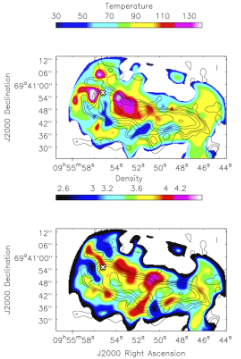The Baryon cycle of M82
At only 4 Mpc, M82 is the nearest starburst galaxy. As such, it is a perfect laboratory for more distant starbursts. Here I use sub-millimeter CO observations to study the cold (T < 150 K) molecular gas within the starburst. This is a project that I started with Dr. Satoki Matsushita while on a NSF summer fellowship in the East Asian Pacific Summer Institute program (EAPSI). The paper was recently accepted by the AstroPhysical Journal, and a copy of it can be found here.
|
Temperature and Density Using the three CO lines we take a Bayesian approach to calculating the temperature and density of the CO gas using the non-LTE code RADEX. The temperature (upper panel) and density plots are shown on the right. The plots on the right show that the disk has a typical temperature of 100 K and a log mean H2 density of 3.6, consistent with previous observations. The super bubble region has a median H2 density (log(n) of 4), and a temperature of 67 K. Similarly, S2 has a high density (near log(n) = 4) and moderate temperature of 62 K.
|
A shocked shell of molecular gasThe density of the molecular outflow shows a thick dense shell of molecular gas with a low density channel punctured in it (figure to the left). We hypothesize that this is the base of a galactic outflow that is being accelerated by a hot, unobserved plasma. This hot plasma also interacts with the molecular gas, and is actually ripping a hole in the shell. This is seen by the low density channel. This molecular shell has a radius of about 100 pc and is centered on an evolved star cluster. These distances and densities are very similar to the distances I find for outflows probed by UV absorption lines. This may indicate that molecular outflows are the beginning of the large scale outflow which is progressively heated as it is accelerated.
|
|



